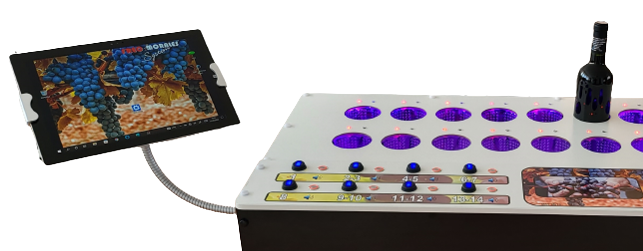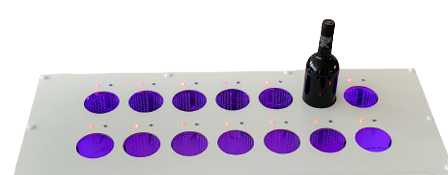

DivineRedWine
DivineRedWine
Por casualidades de la vida y por nuestro trabajo dentro de la investigación en el mundo de la biorresonancia (aplicación de campos electromagnéticos, en el cuerpo humano, como tratamiento terapéutico), descubrimos (utilizando equipos fabricados íntegramente por nuestra empresa y sólo para esta función) cómo el vino, siendo un ser vivo como tal, también puede ser tratado y curar sus enfermedades o defectos y a continuación poder realzar al máximo sus cualidades organolépticas (Sabor, Olor, textura, etc.), sin necesidad de químicos y ni siquiera, abrir la botella.
Tomar un vino en mal estado puede ser dañino para el organismo y en ocasiones mortal. A continuación, podemos ver, varios tipos de defectos o enfermedades, que podemos encontrar en un vino.
TIPOS DE DEFECTOS Y ENFERMEDADES
OLOR A CORCHO
Se dice que tiene olor a corcho cuando se presenta una reacción química de los componentes orgánicos con elementos como el cloro que se da por el lavado del corcho o toneles. También se puede originar este olor por la descomposición de algunos componentes derivados de la utilización de pesticidas con que se tratan las maderas de las estructuras. La recomendación: cambiar al acero inoxidable.
AGRIO O CON ACIDEZ VOLÁTIL
Posee un olor a vinagre, agrio y posee un sabor débil. Posee el aroma del vinagre. Aparece en los vinos que quedan expuestos al oxígeno durante mucho tiempo, esto se debe a que no se cerraron bien o se guardaron de pie, lo que hace que el corcho se seque, se contraiga y permita una micro oxigenación.
AZUFRADO
El olor se asemeja al de una cerilla cuando se enciende, en cuanto al sabor, proporciona sequedad y picor.
REDUCIDO
Presenta un olor a huevos podridos, a ajo o a vegetales en descomposición.
OXIDADO O AJEREZADO
Está oxidado porque cuenta con exceso de oxígeno. Es un vino con aroma rancio y apagado, con color marrón en la mayoría de los casos. Si el vino está en contacto directo con la luz es posible que presente oxidación.
MADERIZADO
Se da por una excesiva guarda en roble. En vinos tintos el defecto se muestra porque el vino tiene poco brillo, tiene un color marrón con olor débil y corto, y su aroma es agridulce. En un vino blanco lo puedes percibir porque su color también es más oscuro que lo habitual, tendrá un aroma sin muchos atributos y su sabor será algo acidulado.
PICADO O AVINAGRADO
Se desarrolla en la superficie del vino al contacto con el aire, formando una película de color blanco que con los días se torna rosada y se sumerge en el mosto restándole alcoholes y otorgándole acidez volátil.
ENFERMEDAD FLORES DEL VINO
Se forman redondeles grisáceos o rosados según el color del vino. Produce la total oxidación del alcohol y una pérdida total de los sabores y aromas. Esta enfermedad se presenta en vinos jóvenes de bajo tenor alcohólico y de débil acidez.
ENFERMEDAD DEL TORNADO O DE LA VUELTA
Descompone diversos componentes del vino como los azucares, glicerina, taninos y en especial el ácido tartárico. Los vinos se enturbian y se tornan achocolatados volviéndolos desagradables, se nota el desprendimiento de gas carbónico, sus causales: vendimias en mal estado o dañadas por el granizo.
ENFERMEDAD DE LA MANITA O AGRIDULCE
Se produce en vinos cuya fermentación se detiene por falta de acidez, produciendo un sabor agrio y dulce a la vez. Esta enfermedad se presenta más en vinos tintos que en blancos.
GUSTO METÁLICO (HIERRO, ZINC, COBRE)
Estos aromas y sabores se deben a que el mosto o vino estuvo en contacto con algún elemento metálico, como tachos de cosecha, cangilones de cintas transportadoras, tanques de hierro mal revestidos, y que el ácido del vino disuelve, lo que le brinda sabores amargos.
MÁS 5 AÑOS DE INVESTIGACIÓN
Uno de nuestros retos, era que una vez modificado, se mantuviera y no solo lo hemos conseguido, si no que, con el tiempo, incluso mejora.
También hemos conseguido en vinos muy fuertes, tanto de alcohol como de taninos, suavizarlos.
DISPONEMOS DE DOS POSIBILIDADES DE TRABAJO:
Una directamente en la botella, ya que, con nuestro proceso, no necesitamos abrir la botella, disponemos de un equipo para hacer 14 botellas a la vez.
La otra forma sería para trabajar el vino a granel, en depósitos de 1.000 l., actualmente disponemos de un equipo para trabajar 1.000 l. al mismo tiempo, aquí sí que es necesario aplicar unas mangueras, ya adecuadas para alimentación, dentro del depósito de 1.000 l.
Nos gustaría, poner a vuestra disposición, nuestra tecnología y experiencia, por si quieren poder hacer alguna prueba experimental con sus productos, sin ningún compromiso y COMPLETAMENTE GRATUITA.
Sería muy interesante, que al menos nos dieran la oportunidad, de poder mostrarlo, siendo una tecnología única en el mundo y patentada por nuestra empresa.
By coincidences of life and our work within the research in the world of bioresonance (application of electromagnetic fields, in the human body, as a therapeutic treatment), we discovered (using equipment manufactured entirely by our company and only for this function) how wine, being a living being as such, can also be treated and cured of its diseases or defects and then be able to enhance its organoleptic qualities to the maximum (Taste, Smell, texture, etc.), without the need for chemicals and not even opening the bottle
Drinking wine in poor condition can be harmful to the body and sometimes fatal. Next, we can see several types of defects or diseases that we can find in a wine.
TYPES OF DEFECTS AND DISEASES
CORK SMELL
It is said that it smells like cork when there is a chemical reaction of the organic components with elements such as chlorine that is produced by washing the cork or barrels. This smell can also be caused by the decomposition of some components derived from the use of pesticides with which the wood of the structures is treated. The recommendation: switch to stainless steel.
SOUR OR WITH VOLATILE ACIDITY
It has a vinegary, sour odor and has a weak taste. It has the aroma of vinegar. It appears in wines that are exposed to oxygen for a long time, this is because they were not closed properly or were kept upright, which causes the cork to dry out, contract and allow micro-oxygenation.
SULFUR
The smell resembles that of a match when lit, in terms of taste, it provides dryness and itching
REDUCED
It has an odor of rotten eggs, garlic or rotting vegetables.
OXIDIZED OR SHELTERED
It is rusty because it has excess oxygen. It is a wine with a rancid and muted aroma, with a brown color in most cases. If the wine is in direct contact with light, it may present oxidation.
WOODEN
It is due to excessive oak aging. In red wines, the defect is shown because the wine has little brightness, it has a brown color with a weak and short smell, and its aroma is bittersweet. In a white wine you can perceive it because its color is also darker than usual, it will have an aroma without many attributes and its flavor will be somewhat acidic.
CHOPPED OR VINEGRATED
It develops on the surface of the wine in contact with the air, forming a white film that turns pink over time and submerges in the must, subtracting alcohols and giving it volatile acidity.
WINE FLOWERS DISEASE
Grayish or pink circles are formed depending on the color of the wine. It produces the total oxidation of the alcohol and a total loss of flavors and aromas. This disease occurs in young wines with low alcohol content and weak acidity.
TORNADO OR SPIN DISEASE
It breaks down various wine components such as sugars, glycerin, tannins and especially tartaric acid. The wines become cloudy and chocolatey, making them unpleasant, the release of carbon dioxide is noticeable, its causes: vintages in poor condition or damaged by hail.
DISEASE OF THE HAND OR SWEET AND SOUR
It is produced in wines whose fermentation stops due to lack of acidity, producing a sour and sweet flavor at the same time. This disease occurs more in red wines than in whites.
METALLIC TASTE (IRON, ZINC, COPPER)
These aromas and flavors are due to the fact that the must or wine was in contact with some metallic element, such as harvest bins, conveyor belt buckets, poorly coated iron tanks, and that the acid of the wine dissolves, which gives it bitter flavors. .
OVER 5 YEARS OF RESEARCH
One of our challenges was that once modified, it would be maintained and not only have we achieved it, but, over time, it even improves.
We have also managed to soften them in very strong wines, both in terms of alcohol and tannins.
WE HAVE TWO WORK POSSIBILITIES:
One directly in the bottle, since, with our process, we do not need to open the bottle, we have equipment to make 14 bottles at a time.
The other way would be to work the wine in bulk, in 1,000 l. tanks, we currently have equipment to work 1,000 l. at the same time, here it is necessary to apply some hoses, already suitable for feeding, inside the 1,000 l tank.
We would like to make our technology and experience available to you, in case you want to be able to carry out an experimental test with your products, without any commitment and COMPLETELY FREE.
It would be very interesting if they at least give us the opportunity to show it, being a unique technology in the world and patented by our company.

